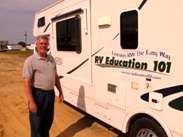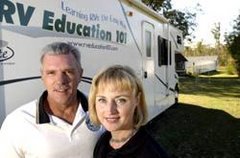I’m sure you have all heard that in 2009 all analog television signal transmission will cease. This applies not only to viewing television in your home, but in your RV too (I hear there will be a grace period but I’m not sure for how long). All analog TVs will require some type of receiver to convert digital, over the air signals, to analog signals that older TVs can display. With a receiver, you can still use your analog TV to receive digital signals, so there is no need to buy another TV! So what is the easiest way to deal with this problem in our RV’s?
Here’s how things currently work in your RV. Between your analog television set, TV antenna and a built in NTSC tuner you are able to pick up free off air programming like ABC, NBC and CBS channels. Analog television has been the standard broadcast technology since TV’s have been around. Analog technology uses magnetic waves to transmit and display the picture and sound you are seeing and hearing. When you are spending the night in a rural type area analog reception is poor, resulting in the poor color, snowy and static picture you see.
Several years ago local television channels started broadcasting a free digital signal in addition to an analog signal. Digital broadcasting technology transmits the information used to make a TV picture and sound as data bits, like a computer. Digital broadcast technology can carry much more information than analog technology, resulting in a DVD quality picture and sound that will never have a poor, snowy or static picture. The problem is your analog TV cannot receive digital broadcast signals, at least not until now.
Winegard recently came out with a digital HD receiver that connects easily between your TV antenna and your analog TV to deliver these crystal clear digital channels. I mentioned earlier that local channels started broadcasting free digital signals several years ago. To receive this free, over the air digital programming you simply connect the Winegard receiver to your TV and scan in the digital channels for the area you are staying in, using the receiver. The Winegard receiver has a built in ATSC tuner that decodes the free digital signals and displays them on your analog television.
Let’s say, for example, that you receive the local NBC affiliate broadcast in your area on channel 10. If your TV antenna is directed towards that station’s origin, and you turn your analog TV to channel 10 you receive the programming. This is an analog channel for the local NBC affiliate. This local channel is also broadcasting a digital signal. Digital channels are multicast, meaning you could pick up as many as six additional channels from the local NBC digital signal. Once you scan the digital signal into memory, on the digital receiver, the digital channel will appear on your TV as the standard analog channel plus a dash (-) or a dot (.) and a number.
It sounds more confusing than it really is, let me try and explain it better. I said a moment ago, as an example, that the local NBC affiliate is broadcast on channel 10 in your area. The digital channels for NBC might appear as 10-1, 10-2, 10-3 etc. 10-1 would be the standard digital channel for regular NBC programming. The additional multicast digital channels (10-2, 10-3, 10-4 etc.) might be a 24 hour news broadcast, 24 hour weather broadcast, 24 hour movie, sports, special features broadcast and more. So, not only is the picture and sound crystal clear, but you are receiving more channels. The same is true of the other local programming available in your area like ABC and CBS. When you tune in your digital channels all available multicasting channels in your area will be available.
If the Winegard receiver is connected to a High Definition capable TV you will receive any free, over the air High Definition programming automatically too. So when things switch over not only will you be able to keep your old analog TV in the RV, but the picture will look like it’s being viewed on a brand new TV.
Mark J. Polk
RV Education 101
Subscribe to:
Post Comments (Atom)







No comments:
Post a Comment